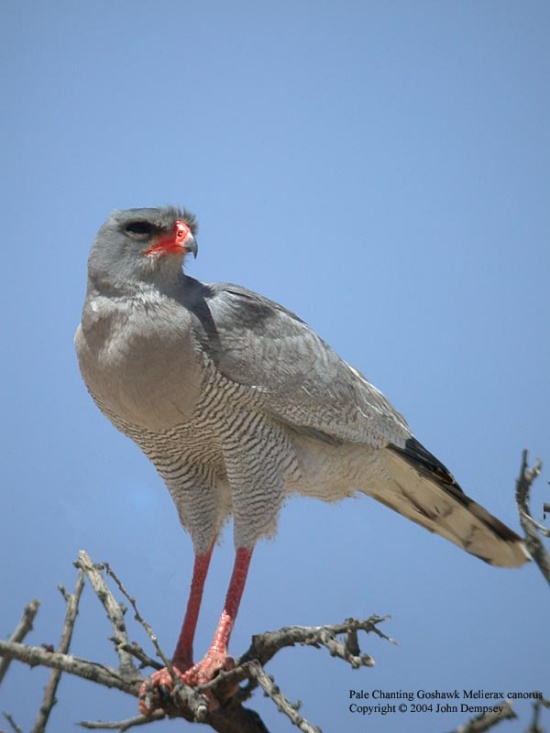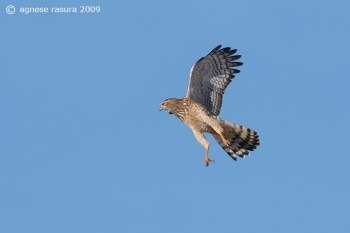(ref) |
|||
| (3 intermediate revisions by 2 users not shown) | |||
| Line 1: | Line 1: | ||
| − | + | [[Image:Pale_Chanting_Goshawk.jpg|thumb|550px|right|'''Adult'''.Photo by {{user|jdbirdman|jdbirdman}}<br/>Photographed: Kruger National Park, R.S.A]] | |
| − | [[Image:Pale_Chanting_Goshawk.jpg|thumb|550px|right|Photo by jdbirdman<br/>Photographed: Kruger National Park, R.S.A]] | + | ;[[:Category:Melierax|Melierax]] canorus |
==Identification== | ==Identification== | ||
Male - grey crown, pale nape and upper back, white upper tail coverts with white bar at base of tail. Central tail feathers black, tipped with white, outer feathers barred grey and white. Primary flight feathers black and grey. Chin, throat, upper breast are pale grey, lower breast, belly, thights are dark grey and white. Eyes and legs are red. Juveniles are duller and sepia brown. | Male - grey crown, pale nape and upper back, white upper tail coverts with white bar at base of tail. Central tail feathers black, tipped with white, outer feathers barred grey and white. Primary flight feathers black and grey. Chin, throat, upper breast are pale grey, lower breast, belly, thights are dark grey and white. Eyes and legs are red. Juveniles are duller and sepia brown. | ||
The calls are a rapidly repeated ''klueee-kli-kli-kli-kli-kli-klip-kleeeep'' and a long, drawn-out, high-pitched ''kleeeee-u, kleeeee-u'' at distinct intervals. | The calls are a rapidly repeated ''klueee-kli-kli-kli-kli-kli-klip-kleeeep'' and a long, drawn-out, high-pitched ''kleeeee-u, kleeeee-u'' at distinct intervals. | ||
| − | + | ====Similar Species==== | |
| + | [[Dark Chanting Goshawk]] | ||
==Distribution== | ==Distribution== | ||
South-west [[Angola]], [[Namibia]], [[South Africa]], [[Botswana]] and south-west [[Zimbabwe]]. | South-west [[Angola]], [[Namibia]], [[South Africa]], [[Botswana]] and south-west [[Zimbabwe]]. | ||
==Taxonomy== | ==Taxonomy== | ||
| − | Two subspecies are sometimes recognised: the nominate race from Cape Province to Orange Free State and ''argentior'' in remainder of range. | + | Two subspecies are sometimes recognised: the nominate race from Cape Province to Orange Free State (South Africa) and ''argentior'' in remainder of range. |
==Habitat== | ==Habitat== | ||
Desert, semi-desert and dry grassland with scattered trees. Requires trees for nesting and uses termite-hills, telephone poles, fenceposts and treetops as lookout posts. | Desert, semi-desert and dry grassland with scattered trees. Requires trees for nesting and uses termite-hills, telephone poles, fenceposts and treetops as lookout posts. | ||
==Behaviour== | ==Behaviour== | ||
| − | The diet includes lizards and insects, small mammals up to the size of a hare. | + | [[Image:Pale_Chanting_Goshawk_Juv_flying_by_agnese.jpg|thumb|350px|right|'''Juvenile'''. Photo by {{user|agnese|agnese}}<br/>[[Namibia]] June 2009]] |
| + | The diet includes lizards and insects, and small mammals up to the size of a hare. | ||
| − | It builds a nest of small sticks and dung, added as lining. It can be up to twenty inches across with a shallow cup of ten inches diameter. 1-2 pale bluish or greenish white, unmarked, eggs are laid at intervals of several days. | + | It builds a nest of small sticks and dung, added as lining. It can be up to twenty inches across with a shallow cup of ten inches diameter. 1-2 pale bluish or greenish white, unmarked, eggs are laid at intervals of several days. Only the female incubates, and when two eggs are laid they hatch at intervals of several days. Only one young is normally reared from a nest of two. The young after leaving the nest may be found near it for some months and in the following year may even be found displaying in the same area. |
| + | ==References== | ||
| + | #{{Ref-Clements6thAug11}}#[http://www.birdforum.net/showthread.php?p=2234337 Birdforum thread] with ID pointers for juvenile Chanting Goshawk | ||
==External Links== | ==External Links== | ||
{{GSearch|Melierax+canorus}} | {{GSearch|Melierax+canorus}} | ||
| − | [[Category:Birds]] | + | [[Category:Birds]] [[Category:Melierax]] |
Revision as of 15:29, 6 September 2011
- Melierax canorus
Identification
Male - grey crown, pale nape and upper back, white upper tail coverts with white bar at base of tail. Central tail feathers black, tipped with white, outer feathers barred grey and white. Primary flight feathers black and grey. Chin, throat, upper breast are pale grey, lower breast, belly, thights are dark grey and white. Eyes and legs are red. Juveniles are duller and sepia brown.
The calls are a rapidly repeated klueee-kli-kli-kli-kli-kli-klip-kleeeep and a long, drawn-out, high-pitched kleeeee-u, kleeeee-u at distinct intervals.
Similar Species
Distribution
South-west Angola, Namibia, South Africa, Botswana and south-west Zimbabwe.
Taxonomy
Two subspecies are sometimes recognised: the nominate race from Cape Province to Orange Free State (South Africa) and argentior in remainder of range.
Habitat
Desert, semi-desert and dry grassland with scattered trees. Requires trees for nesting and uses termite-hills, telephone poles, fenceposts and treetops as lookout posts.
Behaviour
The diet includes lizards and insects, and small mammals up to the size of a hare.
It builds a nest of small sticks and dung, added as lining. It can be up to twenty inches across with a shallow cup of ten inches diameter. 1-2 pale bluish or greenish white, unmarked, eggs are laid at intervals of several days. Only the female incubates, and when two eggs are laid they hatch at intervals of several days. Only one young is normally reared from a nest of two. The young after leaving the nest may be found near it for some months and in the following year may even be found displaying in the same area.
References
- Clements, JF. 2011. The Clements Checklist of Birds of the World. 6th ed., with updates to August 2011. Ithaca: Cornell Univ. Press. ISBN 978-0801445019. Spreadsheet available at http://www.birds.cornell.edu/clementschecklist/downloadable-clements-checklist
- Birdforum thread with ID pointers for juvenile Chanting Goshawk





